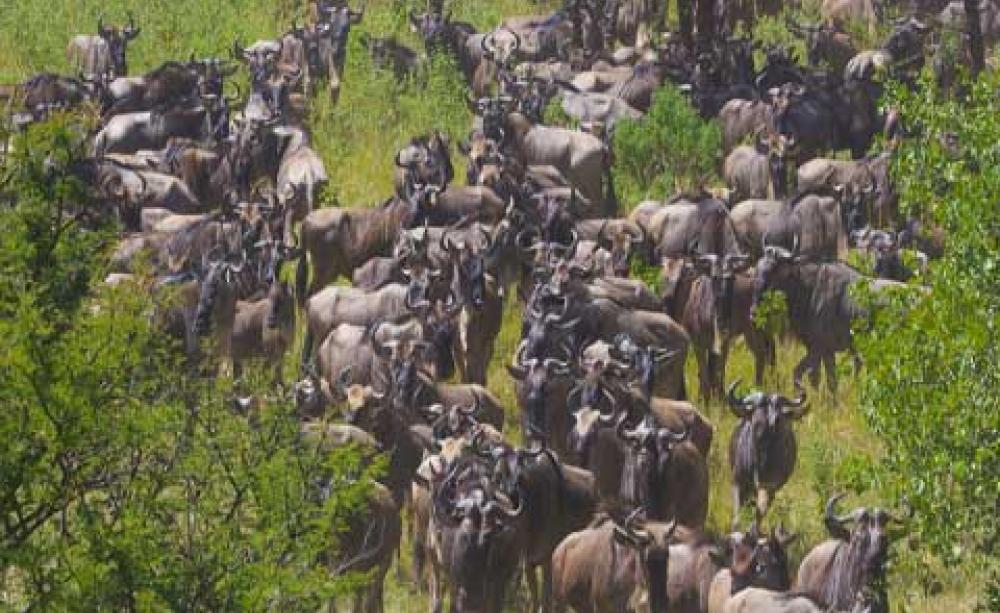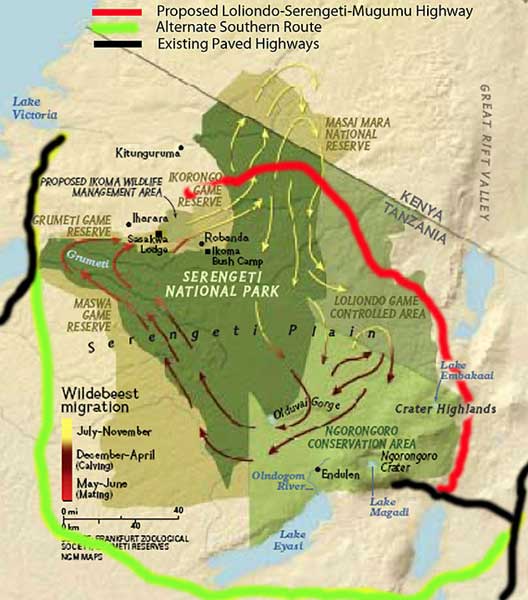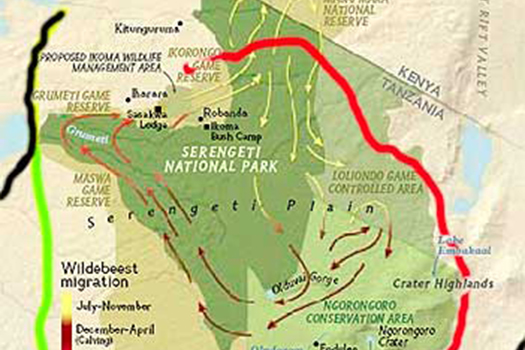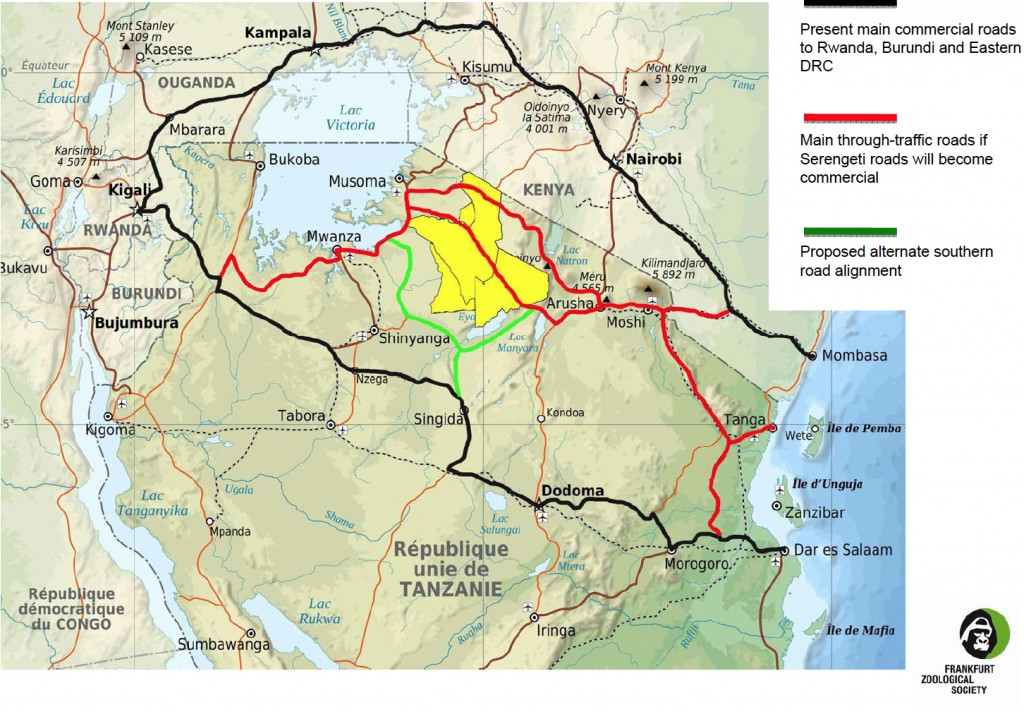Manufaa ya ujenzi wa barabara ya kiwango cha lami itakayo unganisha Karatu na Mwadui moja kwa moja kupitia kaskazini mwa ziwa Eyasi (via Maswa Game reserve).
1) Itaongeza utalii kanda ya ziwa na kanda ya kaskazini. Na kuongeza mapato ya fedha za kigeni kwa kiasi kikubwa.
2) Itaongeza bei ya mazao ya kilimo (na bei ya mifugo) kanda ya ziwa.
3) Itapunguza muda na gharama za usafirishaji kanda ya ziwa. Muda wa safari kutoka Mwanza hadi Arusha utapungua.
4) Itaongeza undugu kati ya kanda ya ziwa na kanda ya kaskazini.
5) Itasaidia watu wa kanda hizo kuwa na exposure zaidi na kupata huduma nzuri zaidi. Interaction ya wachagga na wasukuma itawasaidia wasukuma wa vijijini kiakili, kwenye mambo ya elimu ya msingi na sekondari, kwenye mambo ya huduma nzuri za mabasi ya usafiri, kwenye mambo ya huduma nzuri za afya (hospitali na pharmacy nzuri), itakua shida kwa wasukuma kutapeliwa mazao yao as wanunuzi wataongezeka kutoka Arusha, Nairobi etc. Wachagga watapata exposure kwenye mambo ya madini (almasi, dhahabu etc) na biashara na nchi za upande ule.
6) Itasaidia biashara kati ya kanda ya kaskazini na kanda ya Ziwa. Pia itaongeza ajira na kujiajiri. In the longrun, vijana wengi watapata ajira kwenye sekta ya usafirishaji, maduka, kilimo, mifugo na utalii.
7) Itasaidia sana wasukuma kuendelea, hususan wasukuma wa mkoa wa Simiyu. Kuna miradi michache ya barabara/miundo mbinu ambayo inaweza kuwasaidia wasukuma wa Simiyu zaidi ya mradi huu. Mikoa ya Mwanza, Kagera, Geita, Mara na Kigoma nayo itafaidika. Uganda, Rwanda, Burundi na Eastern Congo nao watafaidika.
8) Itachochea ukuaji wa viwanda kwenye kanda hizo mbili.
9) Itakuza uchumi wa Arusha, Moshi, Mwanga, Same na Tanga. Na itasaidia sana wachagga kuendelea. Wachagga wataweza kuuza mazao yao (ndizi, ulezi etc) kwa unafuu huko kanda ya ziwa. Wachagga vile vile watanunua vitu/mazao kwa bei nafuu kutoka kanda ya ziwa. Vijana wachagga wa vijijini vile vile watanufaika.
10) Itasaidia kanda nyingine za Tanzania kuendelea. Kupanuka kwa uchumi wa kanda ya ziwa kutasababisha watu wa kanda hii kununua bidhaa za viwanda (cement etc) na mazao mbali mbali kutoka maeneo mengine ya Tanzania e.g. Dsm, Dodoma, Mbeya, Lindi/Mtwara, Ruvuma etc.
NB: Kutokana na ufinyu wa bajeti, tunaweza tukaanza na barabara ya vumbi halafu baadae tuka upgrade ikawa ya lami.
Update
Nimecheki ramani, yes ni kweli, barabara za vumbi zipo. Kuna barabara ya vumbi inatoka mji wa Ngorongoro inapitia Kakesio then Banyu (in Maswa Game Reserve) then Banyu tena (after Maswa Game reserve) then Lalago (karibia na Mwadui; kwenye main road ya Mwanza na Musoma). Hii ndio barabara ambayo nashauri ni vizuri ikawekewa lami hivi karibuni, ili itumiwe na watalii na magari madogo binafsi. Barabara hii ni vizuri itumike wakati kuna mwanga wa jua, isitumike usiku. This road is approximately 180 kms.
Baadae barabara ya Seronera, Ruhoga, Nata, Mugela mpaka njia ya Ushashi-Musoma nayo inaweza kuwekewa lami. Ili pia itumike na watalii na magari madogo binafsi. Hii barabara inapitia ndani ya Serengeti National Park na Grumeti Game Reserve. Barabara hii pia ni vizuri itumike wakati kuna mwanga wa jua, isitumike usiku.
Kuna mdau ambae ame elezea kwa urefu na kina, debate ya commercial highway.
Baadae kama kuna mipango ya kujenga commercial highway, ni vizuri commercial highway hiyo ikapitia kusini mwa ziwa Eyasi (nje ya eneo la hifadhi).
1) Itaongeza utalii kanda ya ziwa na kanda ya kaskazini. Na kuongeza mapato ya fedha za kigeni kwa kiasi kikubwa.
2) Itaongeza bei ya mazao ya kilimo (na bei ya mifugo) kanda ya ziwa.
3) Itapunguza muda na gharama za usafirishaji kanda ya ziwa. Muda wa safari kutoka Mwanza hadi Arusha utapungua.
4) Itaongeza undugu kati ya kanda ya ziwa na kanda ya kaskazini.
5) Itasaidia watu wa kanda hizo kuwa na exposure zaidi na kupata huduma nzuri zaidi. Interaction ya wachagga na wasukuma itawasaidia wasukuma wa vijijini kiakili, kwenye mambo ya elimu ya msingi na sekondari, kwenye mambo ya huduma nzuri za mabasi ya usafiri, kwenye mambo ya huduma nzuri za afya (hospitali na pharmacy nzuri), itakua shida kwa wasukuma kutapeliwa mazao yao as wanunuzi wataongezeka kutoka Arusha, Nairobi etc. Wachagga watapata exposure kwenye mambo ya madini (almasi, dhahabu etc) na biashara na nchi za upande ule.
6) Itasaidia biashara kati ya kanda ya kaskazini na kanda ya Ziwa. Pia itaongeza ajira na kujiajiri. In the longrun, vijana wengi watapata ajira kwenye sekta ya usafirishaji, maduka, kilimo, mifugo na utalii.
7) Itasaidia sana wasukuma kuendelea, hususan wasukuma wa mkoa wa Simiyu. Kuna miradi michache ya barabara/miundo mbinu ambayo inaweza kuwasaidia wasukuma wa Simiyu zaidi ya mradi huu. Mikoa ya Mwanza, Kagera, Geita, Mara na Kigoma nayo itafaidika. Uganda, Rwanda, Burundi na Eastern Congo nao watafaidika.
8) Itachochea ukuaji wa viwanda kwenye kanda hizo mbili.
9) Itakuza uchumi wa Arusha, Moshi, Mwanga, Same na Tanga. Na itasaidia sana wachagga kuendelea. Wachagga wataweza kuuza mazao yao (ndizi, ulezi etc) kwa unafuu huko kanda ya ziwa. Wachagga vile vile watanunua vitu/mazao kwa bei nafuu kutoka kanda ya ziwa. Vijana wachagga wa vijijini vile vile watanufaika.
10) Itasaidia kanda nyingine za Tanzania kuendelea. Kupanuka kwa uchumi wa kanda ya ziwa kutasababisha watu wa kanda hii kununua bidhaa za viwanda (cement etc) na mazao mbali mbali kutoka maeneo mengine ya Tanzania e.g. Dsm, Dodoma, Mbeya, Lindi/Mtwara, Ruvuma etc.
NB: Kutokana na ufinyu wa bajeti, tunaweza tukaanza na barabara ya vumbi halafu baadae tuka upgrade ikawa ya lami.
Update
Nimecheki ramani, yes ni kweli, barabara za vumbi zipo. Kuna barabara ya vumbi inatoka mji wa Ngorongoro inapitia Kakesio then Banyu (in Maswa Game Reserve) then Banyu tena (after Maswa Game reserve) then Lalago (karibia na Mwadui; kwenye main road ya Mwanza na Musoma). Hii ndio barabara ambayo nashauri ni vizuri ikawekewa lami hivi karibuni, ili itumiwe na watalii na magari madogo binafsi. Barabara hii ni vizuri itumike wakati kuna mwanga wa jua, isitumike usiku. This road is approximately 180 kms.
Baadae barabara ya Seronera, Ruhoga, Nata, Mugela mpaka njia ya Ushashi-Musoma nayo inaweza kuwekewa lami. Ili pia itumike na watalii na magari madogo binafsi. Hii barabara inapitia ndani ya Serengeti National Park na Grumeti Game Reserve. Barabara hii pia ni vizuri itumike wakati kuna mwanga wa jua, isitumike usiku.
Kuna mdau ambae ame elezea kwa urefu na kina, debate ya commercial highway.
Baadae kama kuna mipango ya kujenga commercial highway, ni vizuri commercial highway hiyo ikapitia kusini mwa ziwa Eyasi (nje ya eneo la hifadhi).













